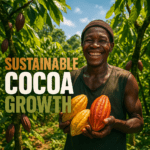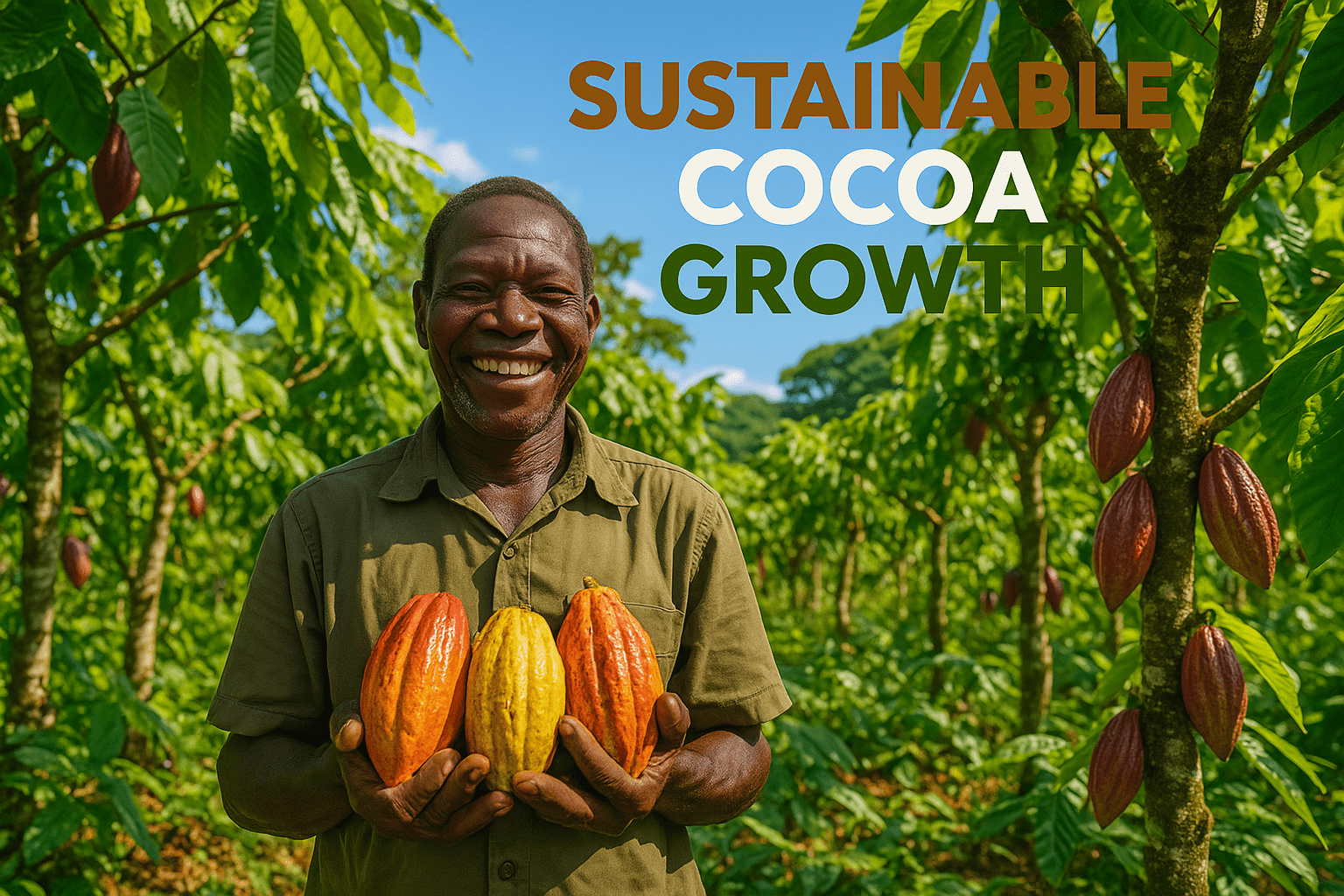

Cameroon's Cocoa: Growth and Green Goals
By Darius Spearman (africanelements)
Support African Elements at patreon.com/africanelements and hear recent news in a single playlist. Additionally, you can gain early access to ad-free video content.
Balancing Cocoa Production and Forest Protection
Cameroon is on a mission to increase its cacao and coffee production while also protecting its precious forests. This strategy is known as “sustainable intensification” (mongabay.com). It means growing more crops on the land they already use, instead of clearing new forest areas. This approach is much better than “destructive extensification,” which involves cutting down more trees for farming (mongabay.com).
However, some environmental groups, like Greenpeace and the Environmental Investigation Agency (EIA), have raised concerns. They believe that the investments from the Central African Forest Initiative (CAFI) in Cameroon might actually encourage deforestation (mongabay.com). Despite these worries, a Cameroonian forestry expert, Ghislain Fomou, points out that while achieving deforestation-free cacao and coffee production is tricky, CAFI funding could have gone to even more harmful agricultural sectors (mongabay.com).
Sustainable Cocoa Farming
Sustainable cocoa farming in Cameroon aims to boost production while also protecting forests and helping farmers earn a living. Organizations like the African Wildlife Foundation (AWF) and Tropical Forest and Rural Development are working with local communities. They want to reduce the pressure on nature, especially around places like the Dja Faunal Reserve (awf.org). These partnerships provide farmers with good quality cocoa seedlings and important farm supplies like fertilizer and pesticides (awf.org). They also train farmers in better ways to grow their crops (awf.org).
Furthermore, these groups help with what happens after the harvest, such as building driers and storage units (awf.org). They also give farmers information about the market to help them get fair prices from middlemen (awf.org). The idea of “forest-friendly chocolate” and “green cocoa” is also being promoted. This ensures that the cocoa can be traced back to its origin and that it does not come from protected areas (unep.org).
What is Sustainable Intensification?
Sustainable intensification means increasing crop yields on existing farmland without expanding into new areas, especially forests. This helps boost production while protecting natural ecosystems. It is the opposite of “destructive extensification,” which involves clearing forests for agriculture.
Challenges with EU Regulations
The European Union's new deforestation-free regulations are creating difficulties for Cameroonian cocoa farmers. This is especially true for those who use traditional agroforestry practices (fairplanet.org). Even though cocoa in Cameroon is often grown under the shade of forest trees, the EU's rules might consider these “deforested farms” (fairplanet.org). This worries smallholder cocoa producers, who fear they will not be able to follow the new rules and sell their cocoa (fao.org).
Many farmers see the ban on expanding into forests as a threat to their livelihoods. This is particularly concerning given the high youth unemployment in Cameroon, which has led many young people to turn to cocoa farming (fairplanet.org). Agroforestry is seen as the only real solution for Cameroon because it has a lot of forest cover (fao.org). However, it is important to figure out which specific agroforestry systems meet the sustainability requirements (fao.org). The main goal is to find a balance between protecting forests and making sure farmers can still earn a living, especially those who also get income from other forest products (fao.org).
International Partnerships and Initiatives
International efforts and partnerships are very important for promoting sustainable cocoa production and protecting forests in Cameroon and the wider Congo Basin. The UN-REDD Programme helps countries with technical advice, training, and policy guidance to get REDD+ financing (unep.org). This funding aims to reduce emissions from deforestation and forest degradation (unep.org). The Cocoa and Forests Initiative, signed by Côte d’Ivoire and Ghana, promises to produce more cocoa on less land through agroforestry (unep.org). This ensures farmers get a steady income and forests are protected (unep.org).
Workshops involving many different groups from the cocoa industry are also held. These include farmers, chocolate makers, government officials, and international organizations (fao.org). They come together to discuss challenges and find solutions for sustainable practices (fao.org). These collaborations are vital for creating a future where cocoa production thrives without harming the environment.
Understanding Agroforestry
Agroforestry is a land-use system where trees or shrubs are grown together with crops or livestock. In cocoa farming, this often means growing cocoa trees under the shade of larger forest trees. This method helps improve soil health, protect biodiversity, and provides diverse income for farmers.
The Role of CAFI in Cameroon
The Central African Forest Initiative (CAFI) is an organization that provides money and guidance to Central African countries, including Cameroon (cafi.org). Its goal is to help these countries put in place policies and practices that reduce deforestation and forest degradation (cafi.org). In Cameroon, CAFI supports sustainable agricultural intensification and promotes the production of cocoa that does not cause deforestation (cafi.org).
CAFI also offers grants to develop projects that aim to increase the production of zero-deforestation cocoa in Cameroon (cafi.org). However, environmental groups have criticized CAFI's investments in Cameroon. They argue that Cameroon is at high risk of deforestation because of its agricultural policies (mongabay.com). Despite these criticisms, some believe that CAFI funding could be used in agricultural sectors that are less harmful to Cameroon's forests (mongabay.com).
“Forest-Friendly” and “Green” Cocoa
“Forest-friendly chocolate” or “green cocoa” refers to cocoa products made in a way that causes minimal harm to the environment, especially by preventing deforestation. These terms usually mean that the cocoa meets certain certification standards or criteria. These standards ensure that the cocoa can be traced back to its origin and that forests are protected (frontiersin.org).
Private organizations, such as IDH (the Sustainable Trade Initiative), are working to create a national plan for deforestation-free cocoa in Cameroon (frontiersin.org). The international standard ISO 34101 for sustainable and traceable cocoa was developed in 2019, but it has not yet become a national standard in Cameroon (frontiersin.org). Certification can actually help cocoa production models perform better financially (frontiersin.org).
Deforestation Trends in Cameroon
Deforestation in Cameroon is a growing concern, and a large part of it is directly linked to the expansion of farming activities, including cocoa and coffee production (frontiersin.org). Cameroon is considered a country at high risk of deforestation because its agricultural policies tend to favor clearing land (mongabay.com). The rate of deforestation in Cameroon is increasing, with more than half of it happening in primary and mature secondary forests (frontiersin.org). This is mainly due to the expansion of food and cocoa crop production (frontiersin.org).
Environmental protection organizations have criticized the way CAFI's investments are being used in Cameroon, pointing to the country's high risk of deforestation (mongabay.com). The situation highlights the urgent need for effective strategies to balance agricultural growth with forest conservation.
Deforestation in Cameroon
Support for Smallholder Farmers
Smallholder farmers in Cameroon are receiving support to help them switch to sustainable practices. This includes community programs, financial aid, and initiatives to develop cocoa production that does not lead to deforestation. The African Wildlife Foundation (AWF) runs community programs that help farmers improve their lives through sustainable cocoa farming and other ways of earning income (awf.org).
The Central African Forest Initiative (CAFI) also provides support for sustainable agricultural intensification and agro-ecological transition, which directly benefits farmers (cafi.org). Additionally, private organizations like IDH are working to create a national plan for deforestation-free cocoa. They are testing this approach in pilot areas with the help of local authorities and certified companies (frontiersin.org). These efforts are crucial for ensuring that farmers can adapt to new regulations and continue to thrive.
Indigenous Communities and Forest Guardians
In Cameroon's cacao country, Indigenous Baka communities are showing that sustainable farming can protect both livelihoods and wildlife. These local Indigenous farmers rely on the rainforest for income from cocoa cultivation, and also for food and medicine. René Etoua Meto’o, a 26-year-old cocoa farmer, shared, “We live with the forest and the forest lives with us. And now we live off the forest. When we take care of the forest it also provides for us and helps our cocoa farms thrive.”
The price of cocoa rose significantly between 2023 and 2024, from about $3 to almost $8 per kilogram. While this increase seems good for Cameroon, where cocoa makes up about 12% of annual exports, high prices also put pressure on the country's rainforests to be cleared for more farming. This puts the rich variety of life in these forests, and the Indigenous communities who depend on them, at risk. Tessa Claude Ndala Mayouya, a communications officer at the United Nations Environment Programme (UNEP), emphasized, “Indigenous people are very important in protecting ecosystems. They are the guardians of these forests, especially in the Congo Basin.”
Producing Premium Cocoa Sustainably
Thanks to the Congo Basin Landscapes Initiative, local Indigenous farmers are able to produce high-quality cocoa without cutting down any trees. This initiative, supported by UNEP and the Global Environment Facility, provides farmers with training and equipment. It helps them increase their yields while stopping deforestation and ultimately preserving the rainforest. Ndala Mayouya explained, “We're helping [countries from the Congo Basin] understand the principle that people need nature to thrive. To understand also that frontiers don't really apply to forests.”
At the end of the production line, the result is Rainforest Alliance certified chocolate, which is now available worldwide. Nadège Nzoyem, the senior Director for West and Central Africa at NGO Rainforest Alliance, stated, “When you buy a bar of chocolates with the green frog, you are not just buying chocolates. You are ensuring that they will continue to produce while conserving biodiversity, while protecting the forest.” With this global cocoa boom, Cameroon hopes to expand its industry while protecting its natural environment and Indigenous communities.
ABOUT THE AUTHOR
Darius Spearman has been a professor of Black Studies at San Diego City College since 2007. He is the author of several books, including Between The Color Lines: A History of African Americans on the California Frontier Through 1890. You can visit Darius online at africanelements.org.
